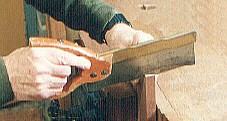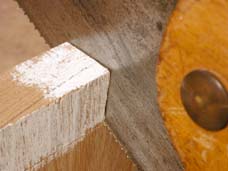

Use a dovetail saw that looks like a tenon saw but has a thinner plate with fine teeth. Use one with a closed handle. Complete beginners might find a slightly blunt saw easier to use. (Less likelihood of jamming)
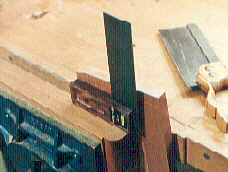
Make sure that the wood is as low as possible in the vice or it will vibrate. If sawing tail sockets, you could try tilting the wood in the vice so that the line in question is vertical, though some people say this makes it even harder.
Check the lighting. The line should be between the light and the saw.
Make sure you are standing comfortably. Balance most of your upper-body weight on the N-S hand. Use a boxer's stance, feet apart. N-S foot forward of the other.
Grip with the thumb against one side of the of handle and the index finger on the other.
Check that the tip of the saw, your wrist and shoulder joint lie in the same plane
Grasp the top of the workpiece and rest the plate of the saw against the tip of the nail of your extended index finger of your non-sawing (N-S) hand.
Balance the sideways pressures between the saw and finger so that the teeth will be in the waste but just grazing the side of the line. (Whatever tool was used to create the line, you will have to saw to the side of the line. 'Splitting the line' would be a serious error).
Apply Woodworking Zen. Breath naturally. Relax. It's a bit like swimming, you need to apply force to those parts that need it, yet at the same time relax the rest of your body.
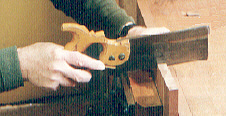
Lift the saw against its own weight and apply a featherlight touch, otherwise the sharp teeth will dig in. If this happens you will then press like fury and things will go wrong from there onwards. A forced saw will probably follow the grain.
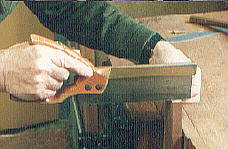
Start sawing at the back edge with the saw making only a very small angle with the wood surface. Otherwise, if starting on the front edge, the the gullets of the teeth tend to lock into the front corner.
Take your time. If you make progress slowly, the saw will not go too deeply with each cut and the natural feedback process will enable you to correct the saw orientation.
Blow away the sawdust between each forward stroke
Once started, saw with the teeth inclined somewhat upwards. The saw will work more easily because you are sawing more with the grain than across it. Continue until you get to the shoulder line.
(Sawing a tenon involves a rigmarole of sawing from each side of the workpiece, but this is rarely necessary for dovetails).
